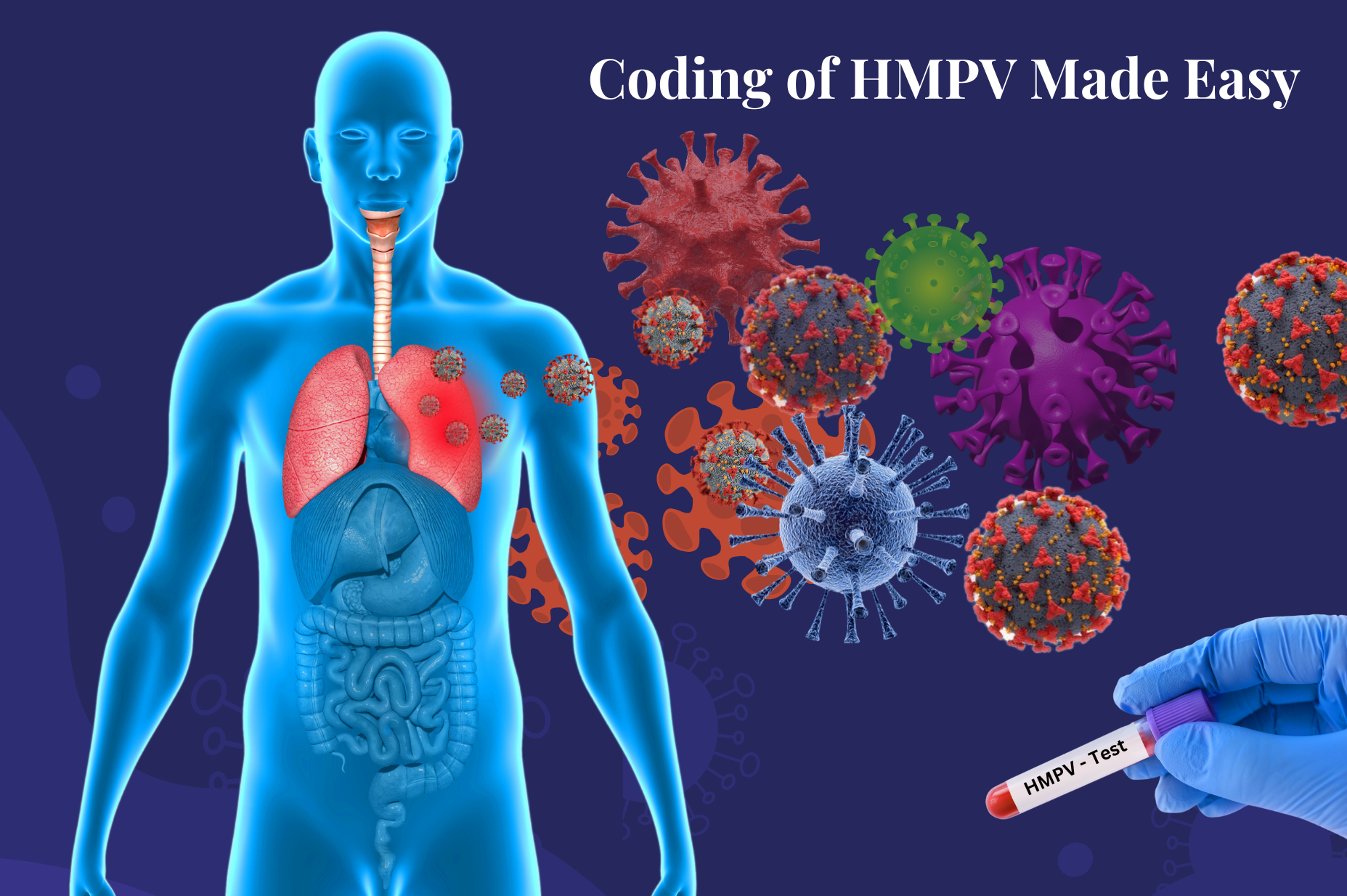HMPV stands for Human metapneumovirus. It’s a common respiratory virus that, like the flu or RSV, causes cold-like symptoms.
What it is?
- A type of virus: HMPV is a single-stranded RNA virus, belonging to the Pneumoviridae family (the same family as RSV).
Coding of HMPV (Human metapneumovirus)
Accurate coding of infectious diseases requires using the ICD-10-CM’s Alphabetic Index to identify the specific organism causing the illness, as this is the primary way these conditions are classified in Chapter
- If HMPV only found code with no associated diagnosis B34.8 – Other viral infection of unspecified site.
- If HMPV found along with Pneumonia unspecified, code as Follow
Pneumonia, unspecified + HMPV (J18.9+B34.8) = J12.3 – Human metapneumovirus pneumonia.
- If HMPV found along with Acute bronchiolitis, Unspecified, code as Follow
Acute bronchiolitis, Unspecified + HMPV (J12.9+B34.8) = J21.1 – Acute bronchiolitis due to human pneumovirus
Codes from chapter 1 take precedence over codes from other chapters for the same condition. For example, urinary tract infection due to candidiasis is classified to code B37.49, Other urogenital candidiasis, rather than to code N39.0, Urinary tract infection, site not specified.
Conditions that are not considered to be easily transmissible or communicable are classified in the appropriate body system chapter, with an additional code from category B95-B97 to indicate the responsible organism. For example, codes N41.00, Acute prostatitis without hematuria, and B95.0, Streptococcus, group A, as the cause of diseases classified elsewhere, are assigned for acute prostatitis due to group A Streptococcus.
- If HMPV found in culture is not associated with above diagnosis (Pneumonia or bronchiolitis ) but with different diagnosis example as follow
Acute pharyngitis along with HMPV should be coded as follow,
Acute pharyngitis due to other specified organism+HMPV = Code first J02.8 followed by B97.81
Key takeaways:
- Accurate coding is crucial: Using the Alphabetic Index is essential to find the correct code based on the specific manifestation of the HMPV Virus infection.
- Specificity matters: Coding depends on whether HMPV is the sole finding or if it’s associated with other diagnoses like pneumonia or bronchiolitis.
- Chapter 1 takes precedence: When HMPV causes a c ondition listed in Chapter 1 (infectious diseases), those codes are prioritized over codes from other chapters.
- Other chapters with B95-B97: For conditions not in Chapter 1, code the condition from the relevant body system chapter and use a B95-B97 code to specify HMPV as the cause.
In essence, this guide emphasizes the importance of understanding the ICD-10-CM structure and using the Alphabetic Index to ensure accurate coding of Human Metapneumovirus Infection. This ensures proper tracking, reporting, and ultimately, better patient care.
Bonus Addition for Identifying the clinical indicators for HMPV
Common Clinical Indicators:
1. Cough: Often the most prominent symptom, ranging from dry to productive.
Rationale: Inflammation of the airways triggers cough receptors.


2. Nasal congestion/Rhinorrhea: Common in upper respiratory tract infections.
Rationale: Viral replication in the nasal passages causes inflammation and mucus production.
3. Fever: May be present, but not always.
Rationale: The body’s immune response to infection can cause fever.


4. Sore throat: Can occur due to inflammation in the throat.
Rationale: Viral replication can directly affect the throat or indirectly due to post-nasal drip.
5. Wheezing: Suggestive of lower respiratory tract involvement (bronchiolitis).
Rationale: Inflammation and mucus buildup in the small airways (bronchioles) cause narrowing and wheezing sounds.


6. Shortness of breath/Dyspnea: Indicates more severe respiratory distress.
Rationale: Lung involvement (pneumonia) or severe bronchiolitis can impair oxygen exchange.
7. Earache/Otitis media: More common in children.
Rationale: Inflammation and fluid buildup in the middle ear due to blockage of the Eustachian tube.


8. Conjunctivitis: May accompany respiratory HMPV symptoms.
Rationale: Viral spread to the conjunctiva causes inflammation.
Indicators of Severe Disease:
1. Tachypnea (rapid breathing): A sign of respiratory distress.
Rationale: The body tries to compensate for decreased oxygen levels by increasing breathing rate.
2. Retractions: Visible sinking of the chest wall during inhalation, indicating difficulty breathing.
Rationale: Increased effort is required to breathe due to airway obstruction or lung stiffness.
3. Hypoxia (low oxygen saturation): Measured with a pulse oximeter.
Rationale: Severe lung involvement or respiratory failure leads to decreased oxygen levels in the blood.
4. Apnea (pauses in breathing): More common in infants and young children.
Rationale: Immature respiratory systems or severe airway obstruction can cause temporary cessation of breathing.
5. Cyanosis (bluish discoloration of the skin): A sign of severe hypoxia.
Rationale: Deoxygenated blood appears bluish.
6. Altered mental status: Confusion, lethargy, or irritability due to decreased oxygen to the brain.
Rationale: Hypoxia can affect brain function.
Rationales for Clinical Presentation:
- HMPV infects the respiratory tract, primarily the epithelial cells lining the airways.
- The virus triggers an inflammatory response, leading to swelling, mucus production, and potential airway obstruction.
- The severity of symptoms depends on factors such as the patient’s age, overall health, and immune status.
- Young children, older adults, and immunocompromised individuals are at higher risk for severe disease.
Remember: These clinical indicators are not specific to HMPV and can be seen in other respiratory infections. Laboratory testing, such as hmpv PCR, is crucial for definitive diagnosis.
Additional Considerations:
- Seasonality: HMPV typically circulates in the winter and spring months.
- Risk factors: Young age, older age, underlying respiratory conditions, and weakened immune systems increase the risk of severe HMPV infection.·
- Complications: Bronchiolitis, pneumonia, respiratory failure, and secondary bacterial infections are potential complications.
Conclusion
In summary, accurate coding of HMPV is essential for proper diagnosis, tracking, and patient care. By following ICD-10-CM guidelines, leveraging the Alphabetic Index, and prioritizing specificity, coders can ensure compliance and support effective reporting. Understanding clinical indicators and the precedence of Chapter 1 codes enhances accuracy, while considering risk factors and complications aids in comprehensive care. This structured approach not only streamlines coding practices but also contributes to better healthcare outcomes for patients with HMPV infections.


